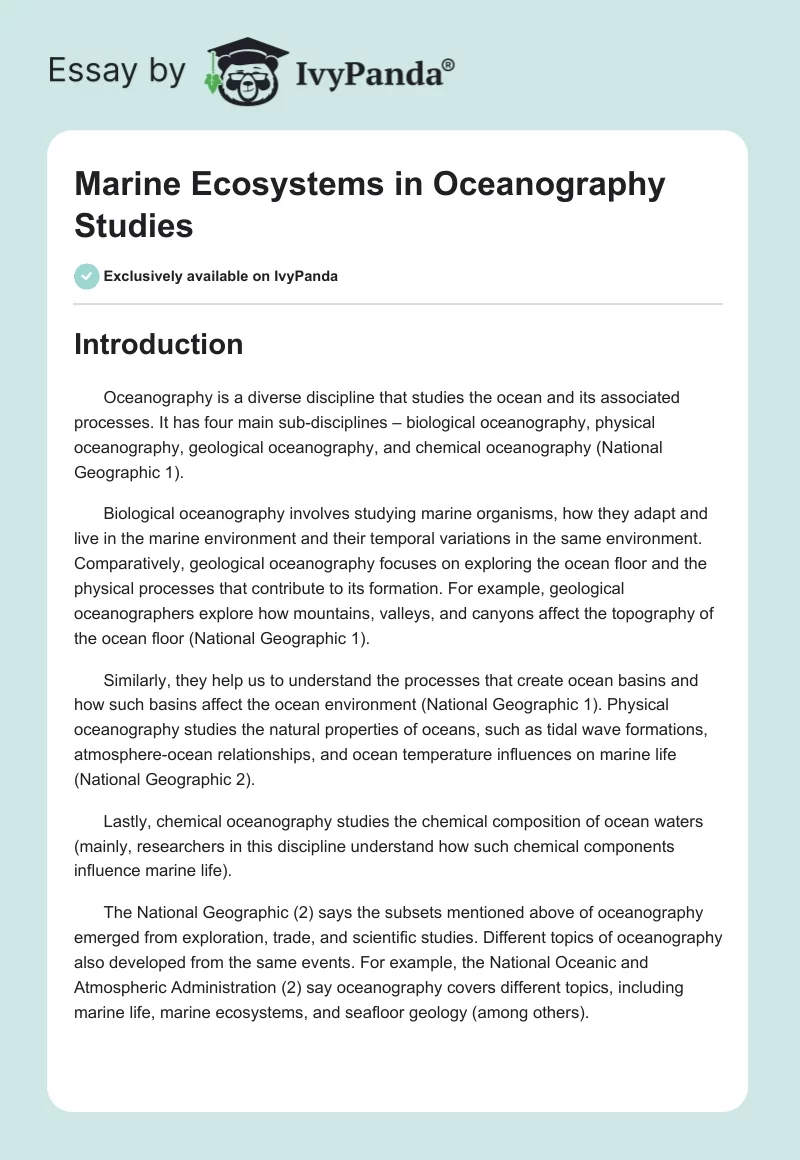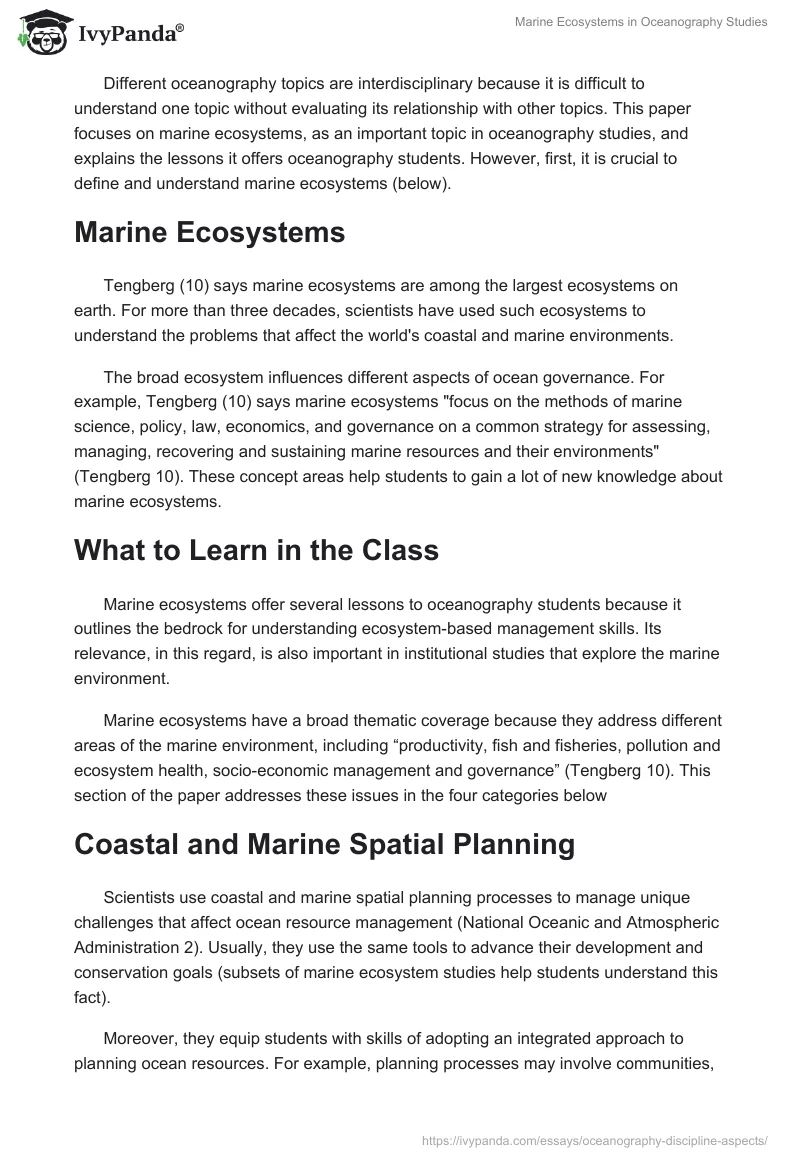Introduction
Oceanography is a diverse discipline that studies the ocean and its associated processes. It has four main sub-disciplines – biological oceanography, physical oceanography, geological oceanography, and chemical oceanography (National Geographic 1).
Biological oceanography involves studying marine organisms, how they adapt and live in the marine environment and their temporal variations in the same environment. Comparatively, geological oceanography focuses on exploring the ocean floor and the physical processes that contribute to its formation. For example, geological oceanographers explore how mountains, valleys, and canyons affect the topography of the ocean floor (National Geographic 1).
Similarly, they help us to understand the processes that create ocean basins and how such basins affect the ocean environment (National Geographic 1). Physical oceanography studies the natural properties of oceans, such as tidal wave formations, atmosphere-ocean relationships, and ocean temperature influences on marine life (National Geographic 2).
Lastly, chemical oceanography studies the chemical composition of ocean waters (mainly, researchers in this discipline understand how such chemical components influence marine life).
The National Geographic (2) says the subsets mentioned above of oceanography emerged from exploration, trade, and scientific studies. Different topics of oceanography also developed from the same events. For example, the National Oceanic and Atmospheric Administration (2) say oceanography covers different topics, including marine life, marine ecosystems, and seafloor geology (among others).
Different oceanography topics are interdisciplinary because it is difficult to understand one topic without evaluating its relationship with other topics. This paper focuses on marine ecosystems, as an important topic in oceanography studies, and explains the lessons it offers oceanography students. However, first, it is crucial to define and understand marine ecosystems (below).
Marine Ecosystems
Tengberg (10) says marine ecosystems are among the largest ecosystems on earth. For more than three decades, scientists have used such ecosystems to understand the problems that affect the world’s coastal and marine environments.
The broad ecosystem influences different aspects of ocean governance. For example, Tengberg (10) says marine ecosystems “focus on the methods of marine science, policy, law, economics, and governance on a common strategy for assessing, managing, recovering and sustaining marine resources and their environments” (Tengberg 10). These concept areas help students to gain a lot of new knowledge about marine ecosystems.
What to Learn in the Class
Marine ecosystems offer several lessons to oceanography students because it outlines the bedrock for understanding ecosystem-based management skills. Its relevance, in this regard, is also important in institutional studies that explore the marine environment.
Marine ecosystems have a broad thematic coverage because they address different areas of the marine environment, including “productivity, fish and fisheries, pollution and ecosystem health, socio-economic management and governance” (Tengberg 10). This section of the paper addresses these issues in the four categories below
Coastal and Marine Spatial Planning
Scientists use coastal and marine spatial planning processes to manage unique challenges that affect ocean resource management (National Oceanic and Atmospheric Administration 2). Usually, they use the same tools to advance their development and conservation goals (subsets of marine ecosystem studies help students understand this fact).
Moreover, they equip students with skills of adopting an integrated approach to planning ocean resources. For example, planning processes may involve communities, state governments, and federal governments. The increased collaboration of their institutional activities (through coastal and marine planning) would reduce user conflict in ocean resource use.
Coincidentally, the National Oceanic and Atmospheric Administration say the increased coordination also “improves planning and regulatory efficiencies, decreases associated costs and delays, engages affected communities and stakeholders, and preserves critical ecosystem functions and services” (1).
Comprehensively, spatial planning would help to understand how marine planning processes emerge from a bottom-up approach to increase coordination and collaboration among different stakeholders in ocean management. Overall, studying coastal and marine spatial planning processes should help students to understand how to organize different spatial scales to improve the marine ecosystem. Similarly, from the same process, students should understand organizational authorities in marine spatial planning.
Ecosystem-based Management
Ecosystem-based management departs from the traditional framework of ecosystem management because it introduces multiple approaches to the same process. In this discipline, I expect to learn about integrating different ecosystem-based management approaches, such as anthropogenic processes, that affect the marine environment. The main aim of this learning process is to make sure people adopt sustainable ecosystems. This way, they would protect the resources and services that marine environments give.
This study area would also help to manage perennial problems in ocean management, such as overfishing and chemical pollution. Indeed, the link between human activities and ecosystem functioning is real because many marine benefits decline because of destructive human activities, such as environmental degradation and pollution.
Managing this problem would help to improve marine ecosystem outputs, such as food, mineral resources, and pharmaceutical products. Guerry (202) agrees with this fact by recognizing the need for people to protect declining marine ecosystems. He says people depend on marine ecosystems for important resources, but the lack of a holistic approach to their management skills leads to their collapse (Guerry 202). Evidence also proves that poor management causes declining marine ecosystems.
Therefore, people need new managerial approaches to reverse the trend. Ecosystem-based management protects this process. For example, the US Commission on Ocean Policy acknowledges this fact by recognizing the need to move from a “piecemeal” management structure of ocean resources to an integrated ecosystem-based approach (Guerry 202).
Marine Pollution
Marine pollution is a tenet of marine ecosystem studies. It concerns ocean resource management by preventing the entry of harmful materials in the marine ecosystem. The elements of pollution may include direct discharge of harmful chemicals to the marine environment, land runoff, atmospheric pollution, and deep-sea mining (National Oceanic and Atmospheric Administration 1).
By understanding the effects of marine pollution on marine ecosystems, we easily understand how different marine conservation initiatives (including planning, research, and regulation) help in alleviating the effects of pollutants in the environment. Through the same framework, students expect to study how human societies have used communication and capacity building skills to reduce the harmful effects of pollution on the marine environment.
Similarly, the same focus should show the challenges experienced in adopting marine ecosystem strategies in different geographical areas. Key issues that are important in this study include understanding how to assess the impact of human activities on the marine environment and knowing which statistical methods to use when doing so.
Fish and Fisheries
Fish and fisheries are important tenets of marine sciences because they focus on marine resource management. This subtopic mainly covers aquatic life management. It also explores how other aspects of marine ecosystem management, such as pollution, affect aquatic life (National Oceanic and Atmospheric Administration 3). Moreover, marine fishing explains how human activities affect aquatic life. For example, it shows how overfishing affects different species of aquatic life.
Unlike popular belief, this discipline is not concerned with how people catch fish; instead, it focuses on understanding other aspects of the marine environment, such as coastal zone management and aquaculture management. This subtopic also helps students to understand how to take part in sustainable economic activities (especially about improving economic sectors that depend on marine resources).
For example, such knowledge would help to lower incidences where people deplete fish numbers in the ocean by overfishing and failing to allow remaining populations to reproduce for the future sustainability of fish supplies.
Conclusion
Oceanography is a diverse discipline that covers different issues about oceans. It includes all aspects of oceanic processes, including ecosystems, ocean waves, marine life, and ocean basin properties (among others). While oceanography students need to understand these aspects of ocean management, this paper focused on marine ecosystems, as a broad and useful topic in oceanography studies.
Based on this focus, this paper establishes that marine ecosystems and their subsets on pollution and fisheries create a cross-sector understanding of the threats and the dynamics of the marine ecosystem. The evidence provided in this paper is useful to students because it helps to improve our understanding of important assessment tools, such as trans-boundary diagnostic analysis, and causal-chain analysis of different processes and issues that affect the marine environment.
This knowledge would also be useful in equipping learners with the skills and contents for developing strategic action programs in large marine ecosystems. Furthermore, this knowledge would help to understand how to strengthen collaborative efforts in marine ecosystem management, including improving information flows, enhancing policy harmonization frameworks, and supporting donor coordination (especially in coordinating marine conservation programs).
Works Cited
Guerry, Anne. “Carus and Daedalus: Conceptual and Tactical Lessons for Marine Ecosystem-Based Management.” Frontiers in Ecology and the Environment 3.1 (2005): 202-211. Print.
National Geographic. Oceanography. 2014. Web.
National Oceanic and Atmospheric Administration. National Ocean Policy. 2014. Web.
Tengberg, Anna. Large Marine Ecosystems: Study of the Concept of Large Marine Ecosystems and its Institutional Relevance for Ecosystem-based Management and Development. 2014. Web.


